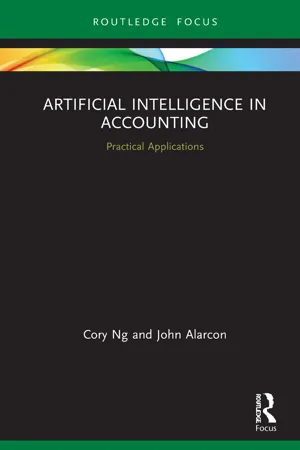
Artificial Intelligence in Accounting
Practical Applications
Cory Ng, John Alarcon
- 120 pages
- English
- ePUB (mobile friendly)
- Available on iOS & Android
Artificial Intelligence in Accounting
Practical Applications
Cory Ng, John Alarcon
About This Book
Artificial Intelligence in Accounting: Practical Applications was written with a simple goal: to provide accountants with a foundational understanding of AI and its many business and accounting applications. It is meant to serve as a guide for identifying opportunities to implement AI initiatives to increase productivity and profitability.
This book will help you answer questions about what AI is and how it is used in the accounting profession today. Offering practical guidance that you can leverage for your organization, this book provides an overview of essential AI concepts and technologies that accountants should know, such as machine learning, deep learning, and natural language processing. It also describes accounting-specific applications of robotic process automation and text mining. Illustrated with case studies and interviews with representatives from global professional services firms, this concise volume makes a significant contribution to examining the intersection of AI and the accounting profession.
This innovative book also explores the challenges and ethical considerations of AI. It will be of great interest to accounting practitioners, researchers, educators, and students.
Frequently asked questions
Table of contents
- Cover
- Half Title
- Series Page
- Title Page
- Copyright Page
- Contents
- List of Illustrations
- Foreword
- Preface
- Acknowledgements
- 1 What Accountants Need to Know
- 2 Applications of AI in Accounting
- 3 Robotic Process Automation (RPA) and AI
- 4 Text Mining
- 5 Contemporary Case Studies
- 6 Challenges and Ethical Considerations of AI
- 7 Future Outlook
- Glossary of Terms
- Index